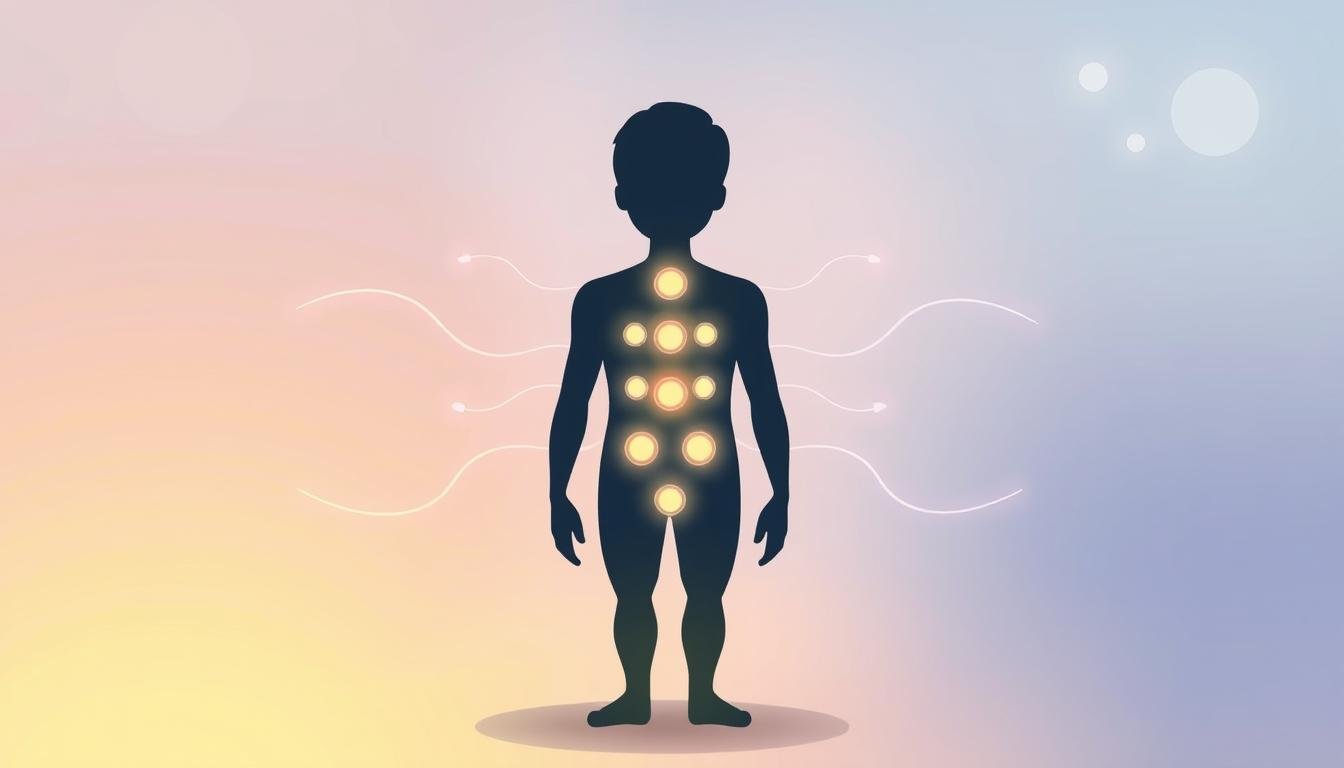Emotional Freedom Techniques (EFT): Tap into Healing
Can tapping on your body really heal emotional wounds? This might sound strange, but it’s at the core of Emotional Freedom Techniques (EFT). It’s a unique way to handle stress and emotional healing.
EFT, or tapping therapy, is becoming more popular. It’s a key part of Energy Psychology. This method mixes ancient Chinese acupressure with modern psychology to tackle emotional and physical problems.
Gary Craig created EFT. It’s based on the belief that negative emotions come from energy system disruptions. By tapping on certain points and focusing on emotional issues, it aims to balance and heal.
Studies show EFT works well for anxiety, depression, and PTSD. In fact, it might be better than traditional therapy or medicine in some cases. With over 100 clinical trials backing it, EFT is changing how we deal with stress.
Let’s dive into EFT’s basics, uses, and the science behind it. You’ll see how this simple tapping method can change how we handle emotions.
Understanding the Fundamentals of Emotional Freedom Techniques (EFT)
Emotional Freedom Techniques (EFT) is a powerful tool for self-help. It comes from Energy Psychology. This method combines ancient Chinese medicine with modern psychology. It helps balance the body’s energy, like acupuncture, but without needles.
Origins and Development of EFT Tapping
EFT, also known as Meridian Tapping, started in the 1990s. It uses meridian points, where energy flows in the body. By tapping these points, it helps with emotional and physical issues.
The Science Behind Energy Psychology
Energy Psychology is the base of EFT. It says our feelings and health are tied to our energy system. Stress or bad emotions can mess with this flow. EFT sends calming signals to the brain, helping to reduce stress and balance energy.
Key Principles of Meridian Tapping
Acupressure Tapping involves tapping on specific points while focusing on a problem. It’s believed to release emotions and aid healing. EFT uses a rating system to measure emotional intensity before and after tapping.
| EFT Component | Purpose |
|---|---|
| Setup Statement | Acknowledge problem and affirm self-acceptance |
| Tapping Sequence | Stimulate meridian points to balance energy |
| Reminder Phrase | Maintain focus on the issue during tapping |
| Intensity Rating | Measure emotional charge before and after |
EFT combines physical and psychological methods. It’s great for managing stress, anxiety, and more. By learning about EFT, people can use it for personal growth and healing.
The Mind-Body Connection in Tapping Therapy
Tapping therapy uses the mind-body connection for emotional healing. It’s an alternative therapy that balances the body’s energy. This helps with both physical and emotional problems.
How EFT Affects the Brain’s Stress Response
EFT tapping has a big impact on the brain’s stress response. Studies show it can lower cortisol levels by up to 43%. This reduces stress a lot.
It helps change the nervous system from fight-or-flight to rest-and-digest mode. This leads to relaxation and better emotional health.
The Role of Meridian Points in Emotional Healing
Meridian points are key in emotional healing with EFT. The method involves tapping on certain spots like the hands, eyes, nose, lips, and more. These points help restore balance to the body’s energy.
By tapping on these spots, EFT aims to fix energy disruptions caused by emotional distress.
Understanding Energy Disruptions and Emotional Blocks
Energy disruptions can cause emotional blocks. EFT tapping helps clear these blockages. It promotes emotional healing.
Research shows EFT can manage anxiety, depression, and PTSD. One study found 80% of veterans no longer had PTSD symptoms after six months of EFT.
“EFT tapping increased happiness by 31% at the time it was performed.”
This mind-body approach is a promising option for those looking for alternative therapies. It helps with emotional and physical well-being.
Step-by-Step Guide to EFT Tapping Protocol
The EFT Tapping Protocol is a simple yet powerful method to tackle emotional and physical issues. It combines ancient Chinese medicine with modern psychology. This mix promotes healing and stress relief.
Setting Up Your Tapping Sequence
To start, pick the issue you want to tackle. Rate your discomfort from 0 to 10. This rating shows how well the tapping works.
Essential Tapping Points and Their Functions
The EFT Tapping Protocol uses nine key points: side of hand, top of head, and more. Each point is linked to emotional and physical responses in the body.
Creating Effective Setup Statements
Setup Statements are key in EFT. They face the problem while showing self-acceptance. For example, “Even though I feel anxious, I deeply and completely accept myself.” Say this while tapping your hand.
Measuring Intensity Levels Before and After
After tapping, check your discomfort level again. Many see a big drop in Intensity Levels. This before-and-after check shows how well EFT works.
Studies show EFT Tapping can cut cortisol levels by 43% in just one hour. It beats traditional talk therapy in reducing stress. This method not only calms the nervous system but also boosts the immune system. It’s a strong tool for emotional and physical health.
Clinical Applications and Benefits
EFT tapping is a powerful stress relief method in alternative therapies. It helps with many conditions, making it a natural choice for healing.
A study by the American Psychological Association found EFT lowers cortisol levels. This shows it’s great for managing stress and anxiety.
EFT is also used for PTSD, depression, and physical pain. A study showed it can lower PTSD scores from 65 to 34 in just a few sessions.
- Improved focus and concentration
- Reduced food cravings
- Alleviation of test anxiety and burnout
- Management of chronic stress and phobias
- Enhanced performance in challenging situations
EFT isn’t just for mental health. It can also help with weight loss and improve sports performance. For example, basketball players saw a 20% increase in free throws after tapping for 15 minutes.
| Condition | EFT Benefit |
|---|---|
| PTSD | Significant score reduction |
| Anxiety | Comparable to CBT results |
| Depression | Reduced symptoms in clinical settings |
| Weight Loss | Changed brain regions associated with cravings |
| Athletic Performance | Improved free throw accuracy by 20% |
More research supports EFT’s effectiveness. It’s being used with other therapies like mindfulness and cognitive behavioral therapy. This offers a full approach to emotional and physical health.
Research-Backed Evidence for EFT Effectiveness
Scientific studies have shown strong support for Emotional Freedom Techniques (EFT). They have found it effective in treating various conditions. EFT effectiveness has been demonstrated through numerous clinical trials and meta-analyses.
PTSD and Trauma Studies
PTSD studies reveal promising results for EFT tapping. In a trial with 59 veterans, six one-hour EFT sessions led to significant reductions in depressive symptoms. Another study found that over half of the participants no longer met PTSD criteria after EFT coaching.
Anxiety Research
Anxiety research consistently shows EFT’s positive impact. A meta-analysis of 14 randomized controlled trials involving 658 participants found a large treatment effect for anxiety disorders. EFT outperformed standard care options in reducing anxiety symptoms.
Physical Pain Management Results
EFT has shown remarkable results in pain management. A study with 203 participants reported a 57% decrease in pain levels after EFT training. Additionally, significant improvements were observed in related physiological markers:
- 8% decrease in resting heart rate
- 37% reduction in cortisol levels
- 6% drop in systolic blood pressure
- 8% decrease in diastolic blood pressure
These findings underscore EFT’s potential as a safe and effective treatment for various psychological and physical conditions. With over 100 studies supporting its efficacy, EFT continues to gain recognition in primary care settings.
Conclusion
Emotional Freedom Techniques (EFT) is becoming a popular choice in self-help. It connects the mind and body to tackle emotional and physical issues. Studies show it might help with anxiety, depression, and PTSD.
A 2016 review found EFT can lower anxiety better than other methods. Another study with 203 people showed big drops in anxiety, depression, and PTSD symptoms after EFT workshops. These results suggest EFT could be a useful addition to traditional treatments.
Even so, the scientific world is still debating EFT’s effectiveness. Some call it pseudoscientific, saying it lacks strong evidence. If you’re thinking about trying EFT, talk to a healthcare provider first. They can help make sure it’s safe for you. More research is needed to fully understand EFT’s place in mental health care.
Source Links
- Tapping into Health: Emotional Freedom Techniques (EFT) for Self-Healing – DHW Programs
- Guidelines for the Treatment of PTSD Using Clinical EFT (Emotional Freedom Techniques)
- What is EFT? – ICEEFT
- Top 10 Must Read Books on EFT
- Mastering Emotional Freedom Techniques: A Step-by-Step Guide
- What Is EFT Tapping?
- What Is EFT Tapping?
- What Is EFT Tapping? Beginner’s Guide to Emotional Freedom Technique
- What Is EFT Tapping? 5-Step Technique for Anxiety Relief
- Tapping Certain Pressure Points May Help Relieve Anxiety, Here’s How It Works
- What is EFT Tapping? Benefits, Steps, and More
- Clinical EFT as an evidence-based practice for the treatment of psychological and physiological conditions: A systematic review – PubMed
- Clinical EFT (Emotional Freedom Techniques) Improves Multiple Physiological Markers of Health
- Frontiers | Clinical EFT as an evidence-based practice for the treatment of psychological and physiological conditions: A systematic review
- Frontiers | Emotional freedom techniques for treating post traumatic stress disorder: an updated systematic review and meta-analysis
- Emotional Freedom Techniques
- What is EFT tapping? Evidence and how-to guide








